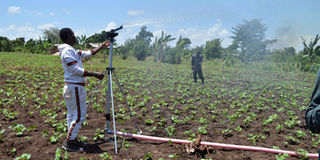Sprinklers ease your farm work

Sprinktech staff test irrigation equipment in a beans garden. Farmers have been encouraged to adopt irrigation on their farms. Photo by George Katongole.
What you need to know:
A sprinkler will help you save time and high costs that come with losing the crop to searing sun. The machines go for between Shs800,000 and Shs15m depending on the speed and capacity, writes George Katongole.
The medium-sized sprinklers made a loud cracking noise as it sprayed water on a demonstration garden the operator, Richard Atugonza, had placed it in.
In 10 minutes, the machine run by petrol generator had completed to irrigate the one-acre vegetable garden.
The sprinkler was on display at a recent Seeds of Gold Farm Clinic in Gayaza at Makerere University Agricultural Research Institute, Kabanyolo (MUARIK). “Many farmers employ several people to irrigate their gardens with watering cans and with bare hands, which is a labour-intensive exercise. But here is a machine that does that work in minutes,” Sam Atulinde Araali said of the machine he bought during the farm clinic.
Atulinde grows watermelons and maize in Pakanyi Sub-county, Masindi District.
Atugonza who works with Buruli Farmers Association, a community-based institution in Masindi District, as a Senior Agronomist in-charge of Staple Food Training, cautions that one must ensure the generator has enough fuel before using the sprinkler.
Solar vs. electric
In terms of initial costs, an electric system is cheaper. According to Atugonza, a 5HP pump, which can pump up to 30,000 litres of water in 30 minutes, costs about Shs5m.
A solar powered pump with similar power can pump up to 12,000 litres per day. The initial cost is about Shs4.5m.
“In the short term, that initial cost of an electric system seems lower. But with increasing fuel prices, the costs keep building up over time,” he says.
An electric powered system is recommended for repairs every 20 hours of operation with regular oil change and general maintenance.
With advancements in pumps and pump controllers, solar water-pumping systems have become fairly easy to install, operate, and maintain.
A solar system comes with a pump, panel, controller and hoses. The downside to the system is the low flow of water compared to electric systems.
“Above all, solar powered systems are environmentally friendly,” he notes.
Financing
Financing remains a key obstacle to availability of solar pumps to as many farmers as possible.
Part of the solution could be found in the Agricultural Credit Finance (ACF) rolled out by the Bank of Uganda as well as agriculture insurance.
But to succeed, the sector needs investment, education, willpower, and regulation. Atugonza hopes to change that.
He said: “Unless farmers are fortunate enough to have full understanding of irrigation, their only option is to watch their crops die.”
Easy to install
The machine, according to Atugonza has the capacity to spray more than 1,000 litres of water on an acre in 10 minutes.
“The speed can be increased, but 10 minutes is a reasonable time. The sprinkler kit is easy to install, remove and re-attach in case of repair or when cleaning. It works with most engines,” he says.
Sprinkler system
Sprinkler irrigation is a system in which water is applied through sprinklers and distributed through pipelines to the field.
This flexible and reliable system provides uniform water application over the entire field.
It’s important to mention that, although sprinkler systems are sophisticated, they also have some limitations.
The most common ones are sensitivity to wind, high initial cost, and groundwater pollution with pesticide and fertilizer residue, and salt leaching, all as a consequence of overhead irrigation.
Despite these limitations, sprinkler systems have been lately highly improved in the area of their effectiveness and operational activities.
Modern sprinkler systems have advanced controllers for watering schedule, high efficient nozzles (sprinklers) which reduce water usage, rain sensors which prevent watering prior to or after the rain, and freeze sensors which stop watering at freezing temperatures.
All these technological advancements of sprinkler systems can make this system more desirable than any other irrigation system type. And not only to farmers but to anyone who enjoys growing crops.
Types of sprinklers
Regarding the sprinkler type as well as the system installation, there are various types of sprinkler irrigation systems: Hand-move: a portable system where irrigation pipes are moved from one field to another. Sprinkler height may be easily adjusted according to crop size. It is a low-cost irrigation system type but it requires severe labour.
Side roll system: wheels move across the field with a lateral sprinkler line. Others are, Linear move system, Centre pivot system, Traveling gun system and Stationary sprinkler systems.




